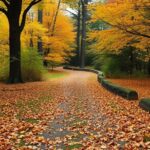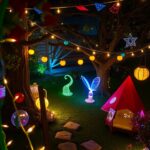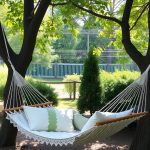Woodland gardens offer a unique charm, blending nature’s beauty with tranquility. Here are over 25 creative ideas to inspire your own woodland oasis, showcasing everything from native plants to thoughtful designs that harmonize with the existing landscape. Whether you’re looking to create a serene retreat or a vibrant ecosystem, there’s something here for everyone.
Using Ground Cover Plants
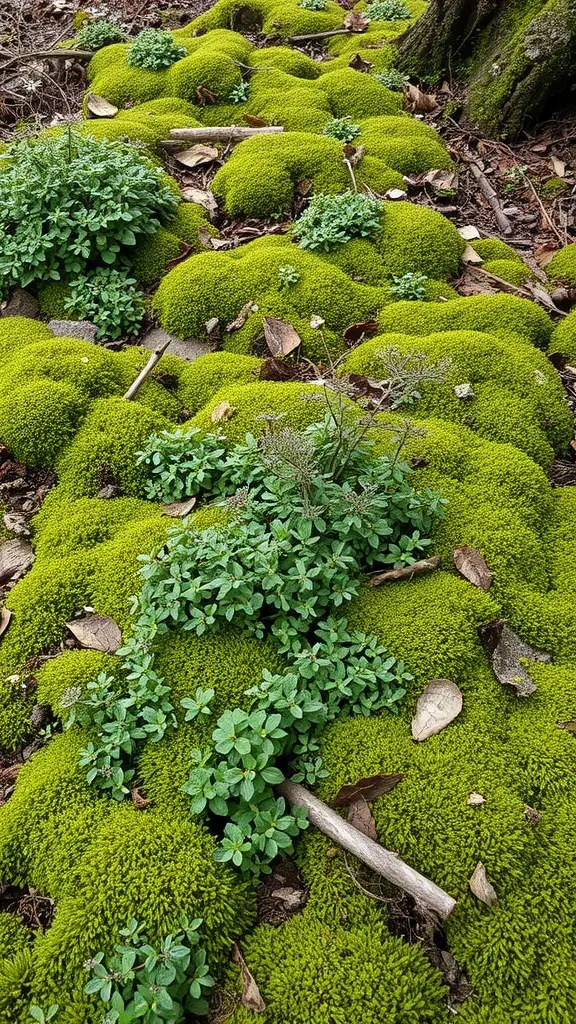
Ground cover plants are a fantastic way to enhance your woodland garden. They create a lush, green carpet that not only looks beautiful but also helps prevent weeds.
The image shows a vibrant mix of moss and low-growing plants, which can thrive in shaded areas. This combination adds texture and color to your garden floor.
Consider using moss for its soft feel and rich color. It’s perfect for creating a serene atmosphere. Pair it with other ground covers like creeping thyme or ajuga for variety.
These plants are low maintenance and can adapt well to different soil types. They also help retain moisture, making them ideal for woodland settings.
Using ground cover plants can transform bare spots into a thriving ecosystem. They provide habitat for small creatures and contribute to the overall health of your garden.
Incorporating Edible Plants
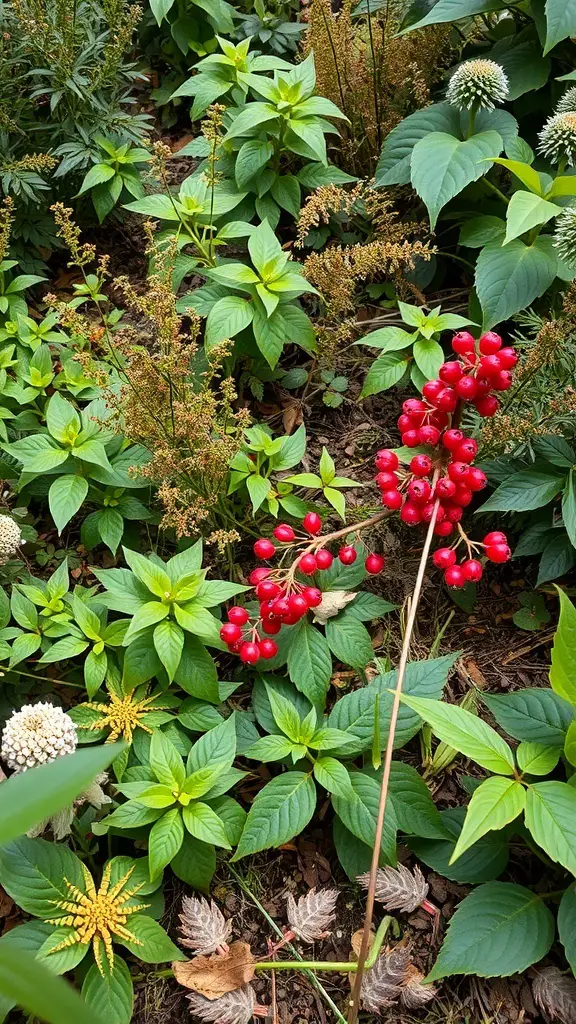
Woodland gardens can be a delightful mix of beauty and practicality. One great way to enhance your garden is by adding edible plants. The image showcases a vibrant array of greenery, with clusters of bright red berries standing out among lush leaves. These berries can be a fantastic addition to your garden, offering both visual appeal and delicious treats.
Consider planting native berry bushes or herbs that thrive in shaded areas. Plants like wild strawberries or black raspberries can flourish under the canopy of trees. Not only do they provide tasty snacks, but they also attract beneficial wildlife.
Mixing in edible flowers, such as nasturtiums or violets, can add color and flavor to your dishes. These flowers are not just pretty; they can be tossed into salads or used as garnishes. Think about how these edible plants can transform your woodland space into a functional and beautiful garden.
Adding a Water Feature
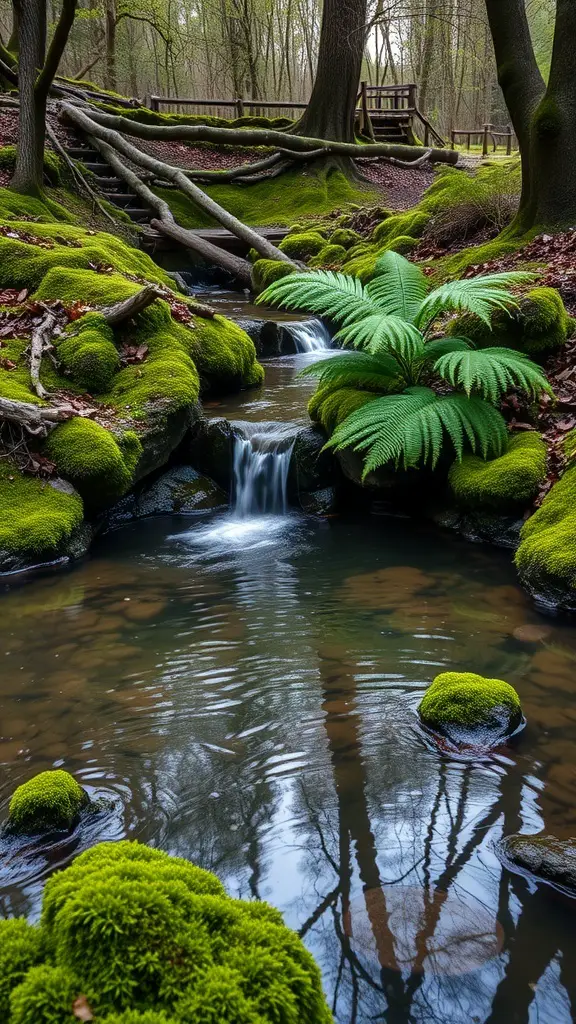
Water features can transform your woodland garden into a peaceful retreat. Imagine the soothing sound of a gentle stream or a small waterfall. This not only adds beauty but also attracts wildlife, creating a vibrant ecosystem.
Consider a natural-looking stream that winds through your garden. You can use stones and moss to blend it seamlessly with the surroundings. A small pond can also be a great addition, providing a habitat for frogs and fish.
For a more modern touch, think about a sleek water fountain. This can serve as a focal point, drawing the eye and adding a touch of elegance. The sound of bubbling water can be very calming, perfect for relaxation.
Lighting can enhance your water feature, making it a stunning sight at night. Use soft lights to highlight the water and surrounding plants. This creates a magical atmosphere that you and your guests will love.
Creating a Natural Pathway
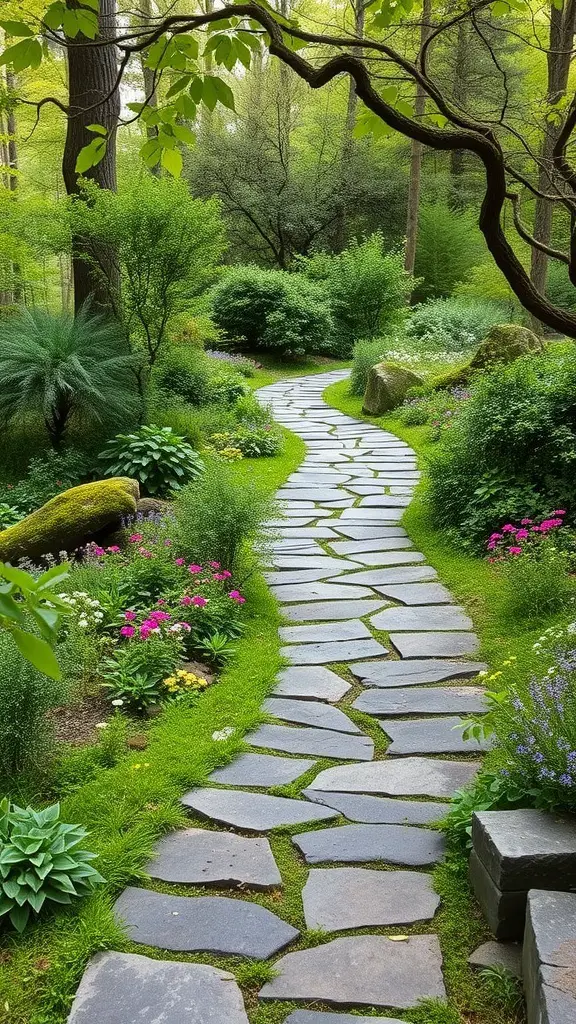
Creating a natural pathway in your woodland garden can transform the space into a welcoming retreat. The image showcases a beautifully laid stone path that winds through lush greenery and vibrant flowers. This kind of pathway invites exploration and adds charm to any garden.
Using natural stones for the path not only blends well with the surroundings but also provides a sturdy surface for walking. You can choose irregular shapes for a more organic look or uniform stones for a cleaner appearance. Surrounding the path with diverse plants enhances the visual appeal and creates a serene atmosphere.
Consider incorporating low-growing plants along the edges. They can soften the look of the stones and add color throughout the seasons. Adding a few larger rocks or boulders can also create focal points, making the pathway feel more integrated with nature.
Lighting can play a key role too. Solar-powered lights along the path can illuminate it at night, making it safe and inviting. This way, you can enjoy your woodland garden even after sunset.
Creating a Wildlife Habitat
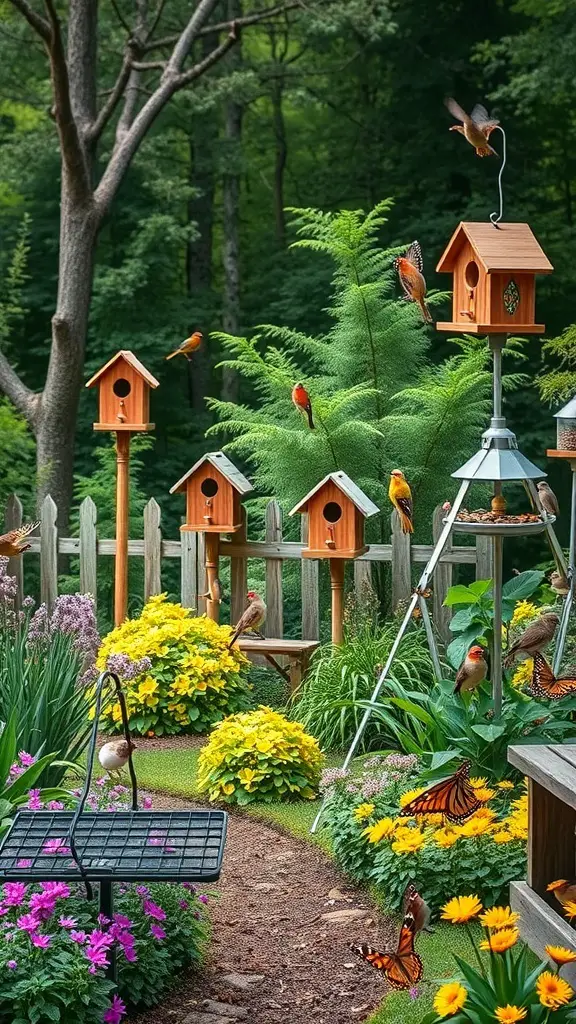
Transforming your garden into a wildlife habitat can be a rewarding experience. The image shows a vibrant garden filled with colorful flowers, birdhouses, and butterflies. This setup invites various creatures, making your outdoor space lively and engaging.
Start by adding birdhouses like those in the image. They provide shelter for birds and encourage them to visit. Choose different designs and sizes to attract various species. Placing them at different heights can also enhance the appeal.
Incorporate native plants that bloom at different times of the year. This ensures a continuous food source for pollinators like butterflies and bees. The bright flowers in the picture not only add beauty but also attract these essential insects.
Consider adding a bird feeder, as shown in the image. It offers a reliable food source, especially during winter months. Fill it with seeds that attract local birds, and watch them flock to your garden.
Creating a small water feature, like a birdbath, can also be beneficial. Birds need water for drinking and bathing. A simple birdbath can be a delightful addition, drawing in more wildlife.
Lastly, leave some areas a bit wild. Piles of leaves or logs can provide shelter for insects and small animals. This natural approach can help maintain a balanced ecosystem right in your backyard.
Utilizing Vertical Space
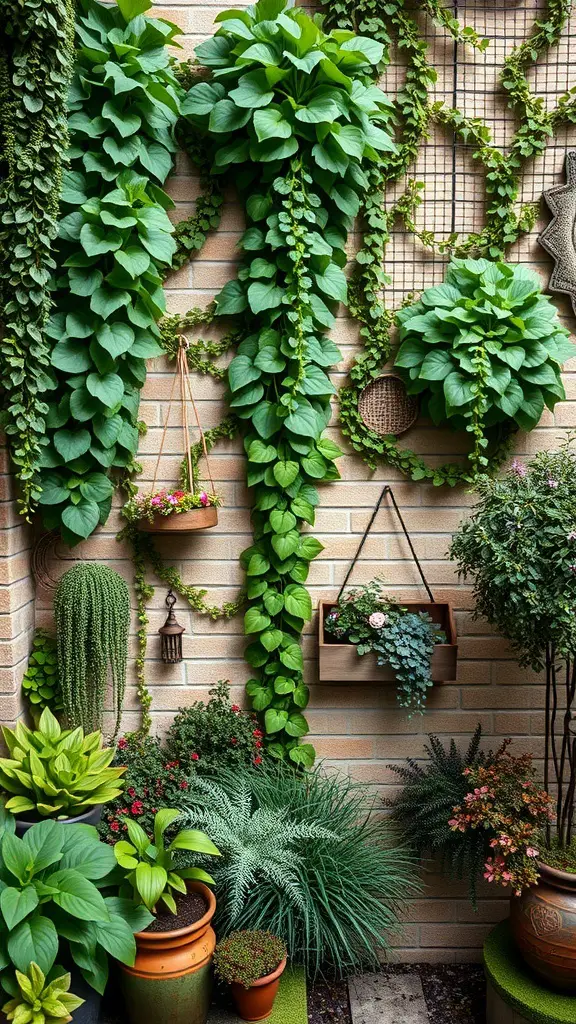
Vertical gardening is a fantastic way to make the most of limited space. This image showcases a beautiful example of how to transform a plain wall into a lush green display. The use of trellises and wall-mounted planters allows plants to climb and cascade, creating a stunning visual effect.
Consider using a mix of trailing and upright plants to add depth. Ferns and ivy can drape elegantly, while sturdier plants can fill in the gaps. Hanging baskets are also a great option for adding color and variety.
Incorporating different textures and shades of green can make your vertical garden more interesting. You can even add decorative elements like lanterns or wall art to personalize the space. This approach not only beautifies your garden but also maximizes your planting area.
Designing a Cozy Seating Area
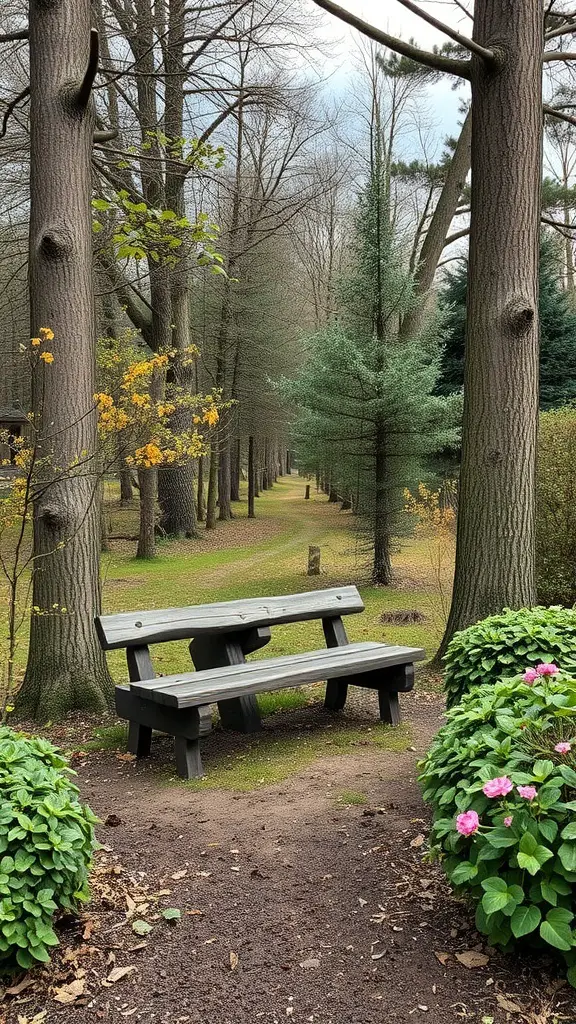
Creating a cozy seating area in your woodland garden can transform it into a perfect retreat. Imagine a simple wooden bench placed along a winding path, surrounded by lush greenery and colorful flowers. This setup invites you to sit back and enjoy nature.
Consider adding cushions to the bench for extra comfort. Soft, weather-resistant fabrics can make your seating area more inviting. You might also want to place a small side table nearby for your favorite drink or a good book.
Incorporating plants around the seating area adds to the charm. Choose flowering shrubs or low-maintenance perennials that bloom throughout the seasons. This not only enhances the beauty but also attracts butterflies and bees.
Lighting can play a key role too. String lights or lanterns can create a warm glow as the sun sets, making your seating area a lovely spot for evening relaxation.
Finally, think about privacy. Adding tall plants or a trellis can create a sense of seclusion, making your cozy nook feel like a hidden gem in the garden.
Incorporating Native Plants
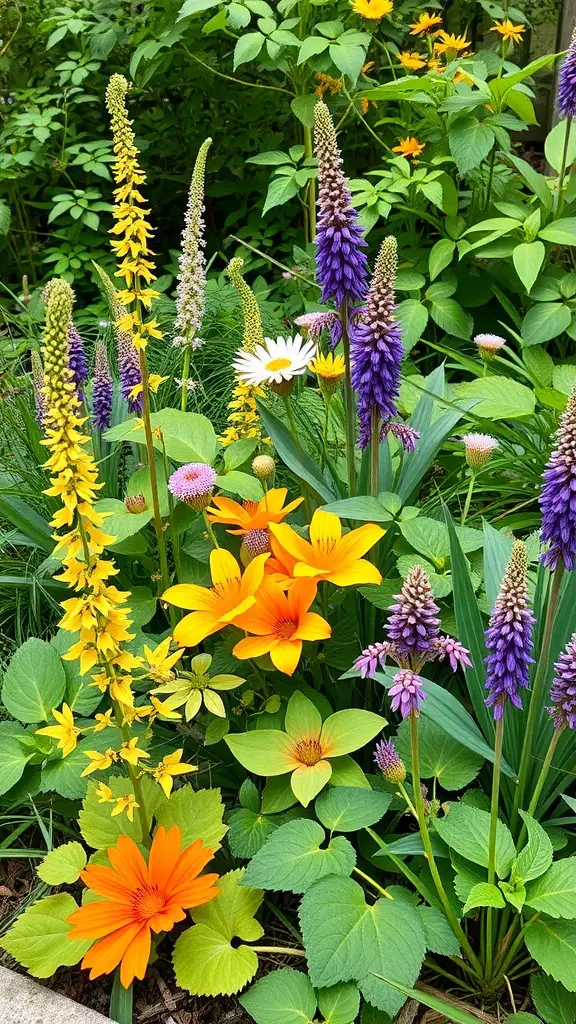
Native plants are a fantastic choice for woodland gardens. They thrive in local conditions and support local wildlife. The image showcases a vibrant mix of native flowers, each adding its unique charm to the garden.
Consider using plants like purple loosestrife, daisies, and yellow daylilies. These not only bring color but also attract pollinators like bees and butterflies. Grouping these plants together can create a stunning visual impact.
Mixing different heights and colors can enhance the natural beauty of your space. Tall flowers can stand proudly at the back, while shorter ones can fill in the front. This layering effect mimics the natural growth patterns found in woodland areas.
Don’t forget about foliage! Leafy plants can provide texture and contrast to the blooms. Incorporating a variety of greens can make your garden feel lush and inviting.
Lastly, consider the seasons. Choose plants that bloom at different times to ensure your garden is always alive with color. This way, you can enjoy the beauty of your woodland garden year-round.
Creating a Themed Garden Area
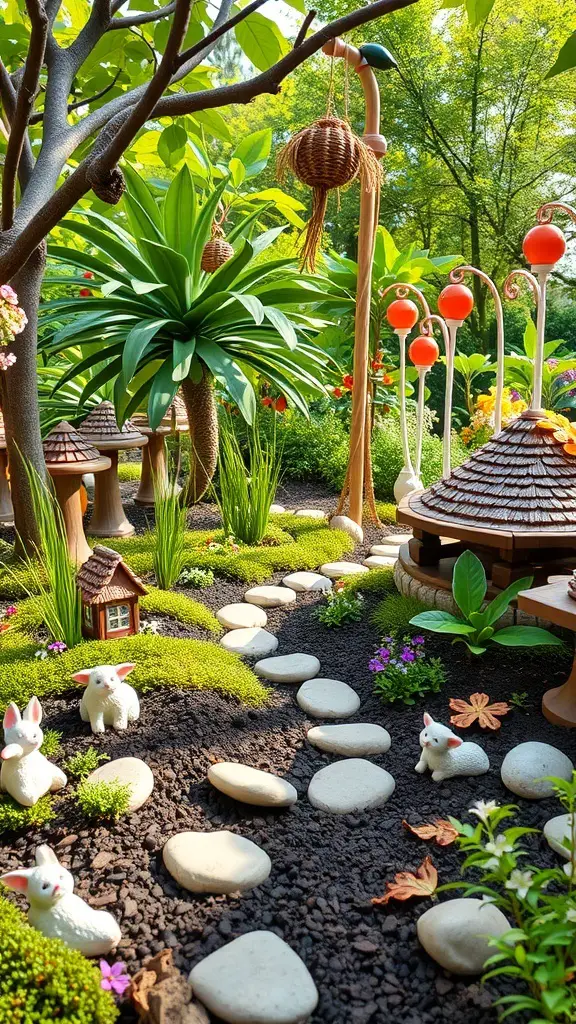
Imagine stepping into a woodland garden that feels like a scene from a fairy tale. This image showcases a charming setup with whimsical elements that invite you to explore. The path made of smooth stones leads you through lush greenery and playful decorations.
Consider adding miniature houses and cute animal figurines to bring a sense of magic to your garden. These little touches can spark joy and create a delightful atmosphere. The vibrant plants and flowers add color and life, making the space feel inviting.
Think about incorporating seating areas where you can relax and enjoy the beauty around you. A small gazebo or a cozy bench can serve as a perfect spot to unwind. With the right decorations and plants, you can create a themed garden that reflects your personality and brings happiness to your outdoor space.
Incorporating Garden Art
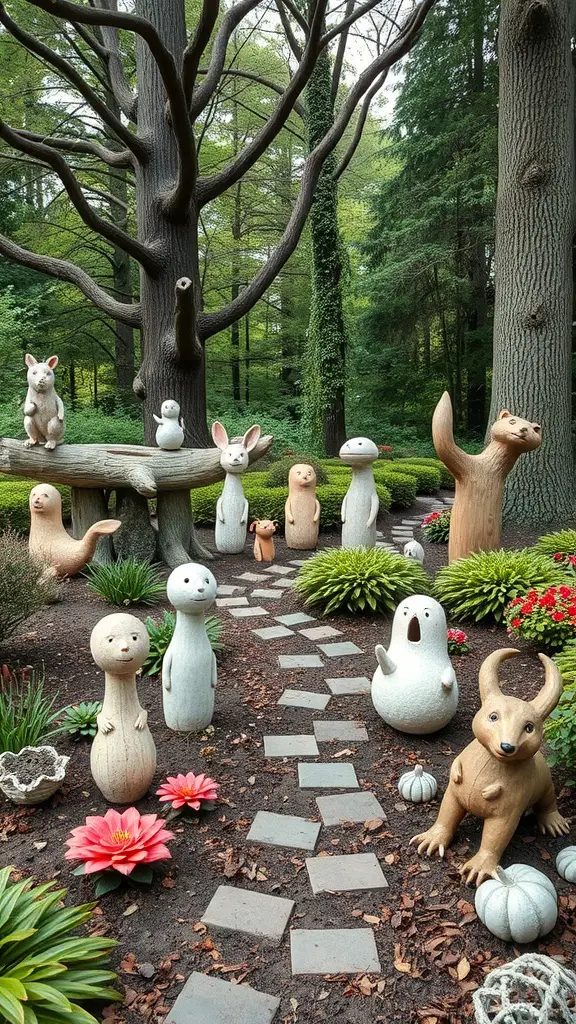
Garden art can truly bring a woodland space to life. Imagine walking through a lush green area and being greeted by charming sculptures of animals and whimsical figures. These playful pieces add a sense of fun and personality to your garden.
In the image, you can see a variety of adorable animal sculptures scattered along a stone pathway. Each figure has its own unique expression, inviting visitors to explore further. This kind of art creates a delightful atmosphere, making the garden feel like a storybook setting.
Consider adding similar sculptures to your own garden. They can be made from various materials like stone, ceramic, or metal. Choose pieces that resonate with your style, whether it’s cute, modern, or rustic. Grouping different sizes and shapes can create visual interest and encourage exploration.
Don’t forget about the plants! Pairing your art with vibrant flowers and greenery enhances the overall look. Think about using colorful blooms that complement the sculptures. This combination can transform your garden into a magical retreat.
Creating a Seasonal Color Palette
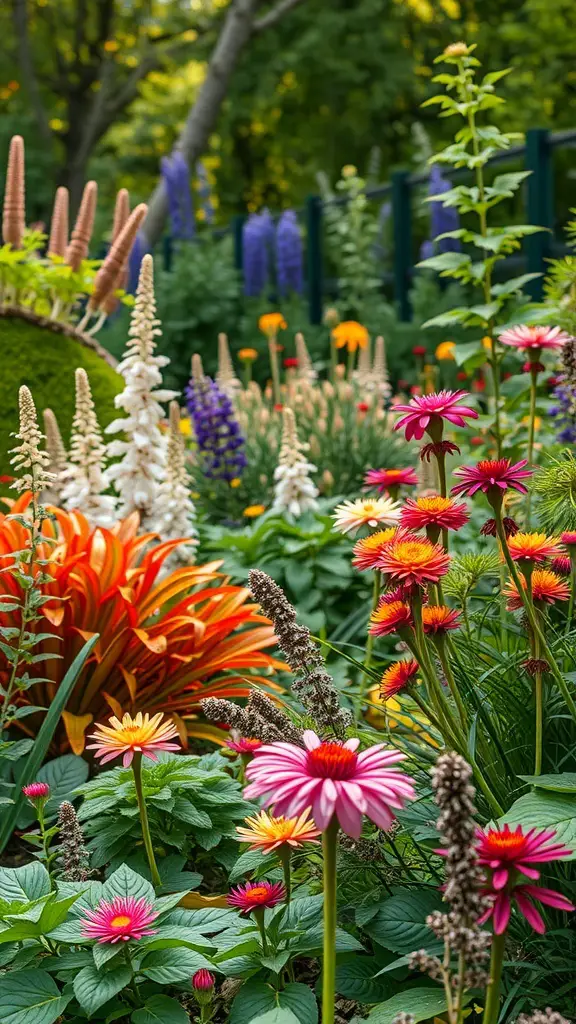
When designing a woodland garden, think about the colors that will shine through each season. The image shows a vibrant mix of flowers, showcasing how different hues can create a lively atmosphere.
In spring, opt for pastel colors like soft pinks and whites. These shades can bring a fresh feel as new blooms emerge. As summer rolls in, bold colors like bright oranges and deep purples can take center stage, just like the striking flowers in the image.
For fall, consider warm tones like reds and yellows. These colors can mimic the changing leaves and create a cozy vibe. Finally, in winter, evergreen plants can provide a backdrop of green, while berries or winter blooms add splashes of color.
Mixing these colors thoughtfully can help create a garden that feels alive year-round. Play with different flower heights and shapes to add depth and interest to your design.
Building a Fire Pit

A fire pit can be a fantastic addition to your woodland garden. It creates a cozy spot for gatherings and adds warmth to your outdoor space. Imagine sitting around the fire with friends, sharing stories under the stars.
When planning your fire pit, think about the materials. Stone or brick can blend beautifully with the natural surroundings. You can also consider a simple metal fire bowl for a more modern look.
Placement is key. Choose a location that feels inviting, perhaps surrounded by trees for a sense of privacy. Ensure it’s a safe distance from any flammable materials.
Don’t forget seating! Comfortable chairs or benches will encourage everyone to relax and enjoy the fire. Adding some cushions can make it even cozier.
Finally, think about lighting. String lights or lanterns can enhance the atmosphere, making your fire pit a perfect evening retreat.
Implementing Sustainable Practices
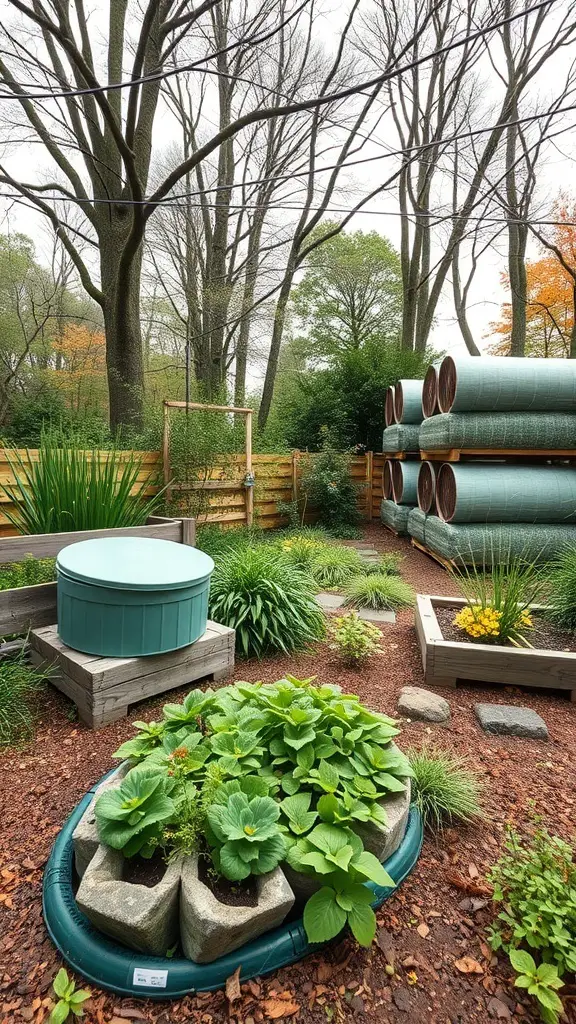
This image showcases a charming woodland garden that emphasizes sustainability. The garden features a variety of plants, including lush greens and vibrant flowers, all arranged thoughtfully. The use of raised beds and a circular water feature adds to the visual appeal while promoting eco-friendly gardening practices.
To create a sustainable garden like this, consider using native plants that thrive in your local environment. They require less water and maintenance, making them a smart choice. Incorporating composting bins can also help recycle organic waste, enriching the soil naturally.
Another idea is to collect rainwater for irrigation. This not only conserves water but also reduces your utility bills. The circular water feature in the image could serve as a perfect spot for rainwater collection. Additionally, using recycled materials for garden structures, like the wooden raised beds seen here, can minimize waste and enhance the garden’s rustic charm.
Designing Layered Plantings

Layered plantings create depth and interest in a woodland garden. This image showcases a beautiful arrangement of plants, where taller ferns and shrubs stand proudly behind vibrant flowers. The mix of textures and colors draws the eye and invites exploration.
Start with taller plants like ferns and small trees at the back. These provide a lush backdrop and help frame the garden. In the middle, consider medium-height plants that add variety. Finally, place shorter flowers in the front to create a colorful border. This layering not only looks great but also helps with plant health by ensuring each type gets the right amount of sunlight.
Don’t forget to think about seasonal changes. Choose plants that bloom at different times to keep your garden lively throughout the year. Mixing evergreen plants with seasonal flowers can also maintain visual interest even in winter.
Designing a Shade Garden
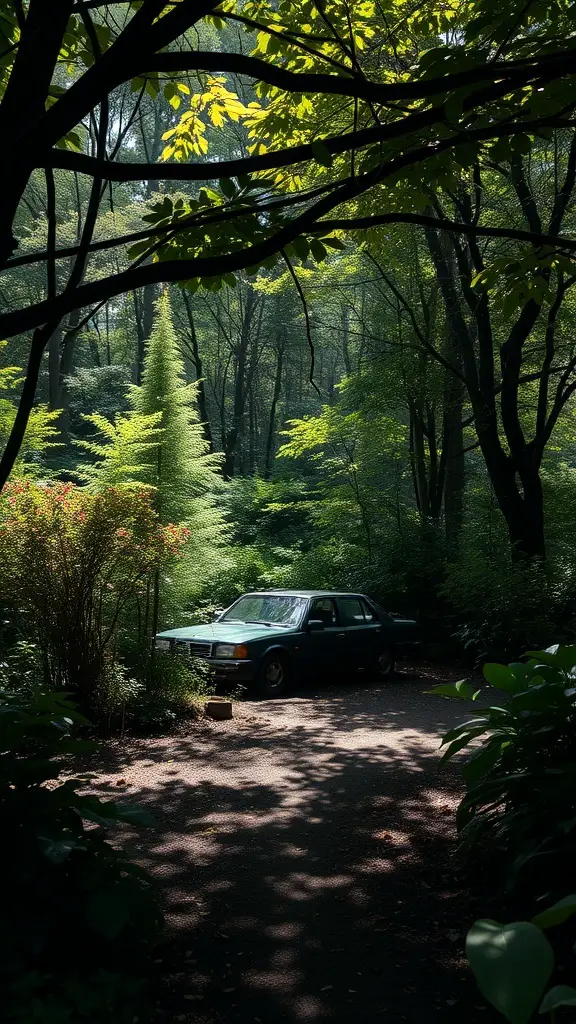
Creating a shade garden can be a delightful way to embrace the beauty of woodland areas. The image shows a serene scene where lush greenery surrounds a quaint pathway, leading to a parked car. This setting highlights how nature can blend seamlessly with everyday life.
When designing your shade garden, think about incorporating various plant heights and textures. Tall ferns and bushy shrubs can add depth, while low-growing plants can create a soft carpet effect. This mix not only enhances visual interest but also mimics the natural layers found in woodland environments.
Consider adding pathways that wind through your garden. A gravel or stone path, like the one in the image, invites exploration and can guide visitors through the lush foliage. This design element can also help define different areas within your garden.
Lighting plays a key role in a shade garden. Strategically placed lights can illuminate pathways and highlight specific plants, creating a magical atmosphere at night. Use soft, warm lights to maintain the cozy feel of the space.
Finally, don’t forget to include seating areas. A simple bench or a couple of chairs can provide a perfect spot to relax and enjoy the tranquility of your garden. This makes your shade garden not just a visual delight but also a functional space for unwinding.

